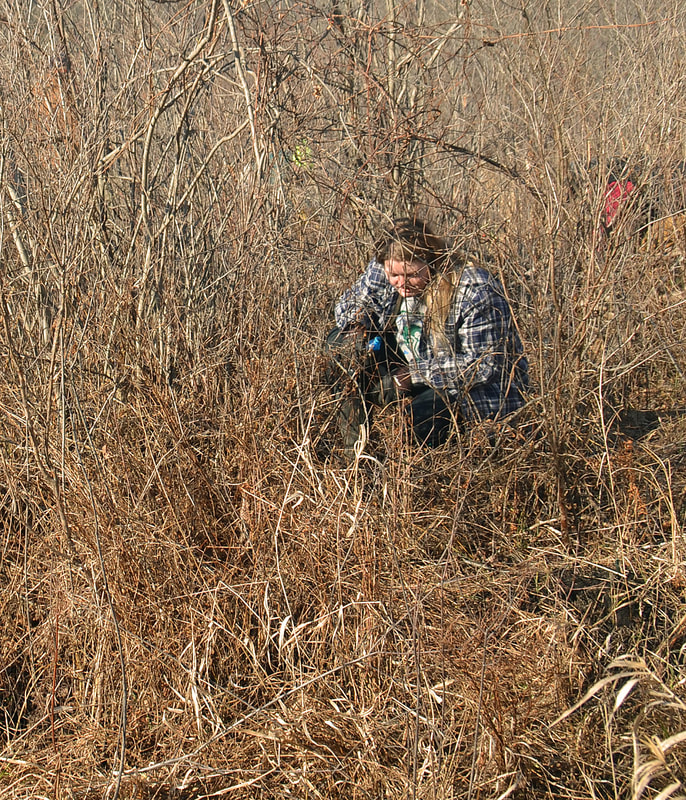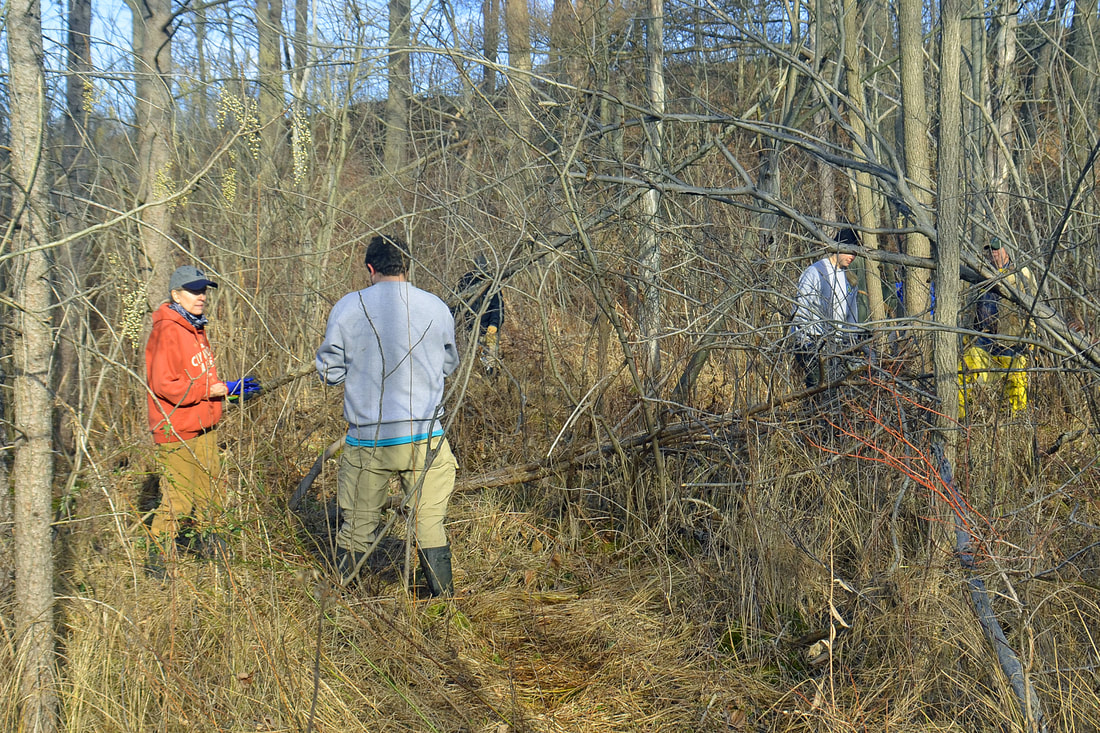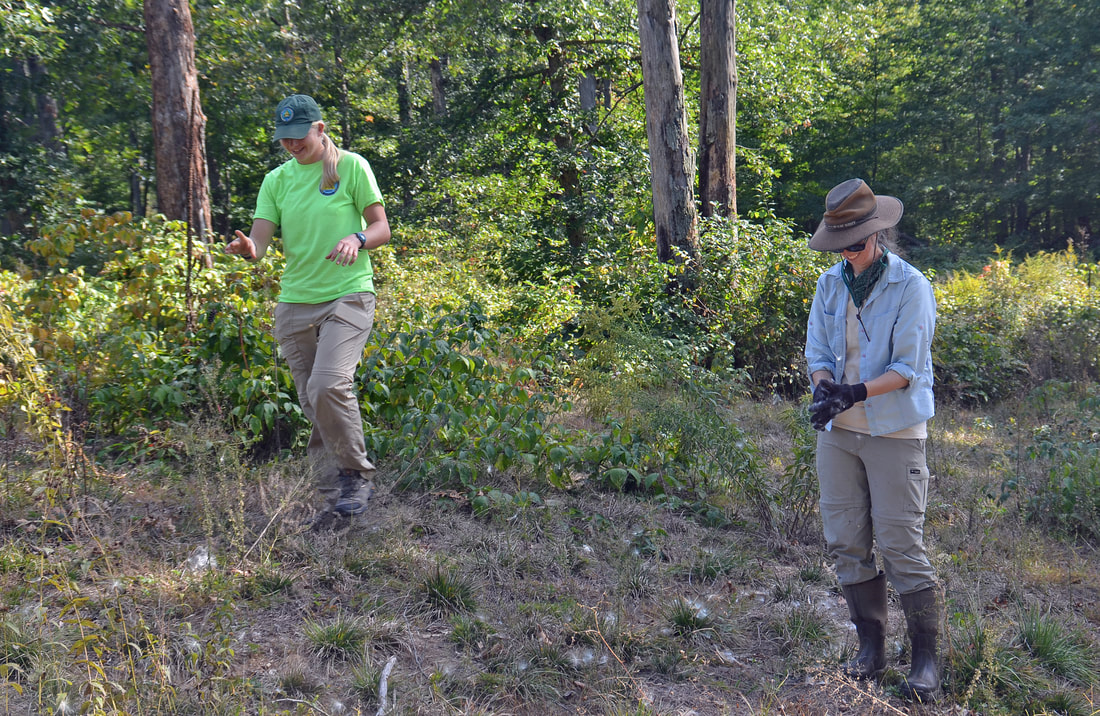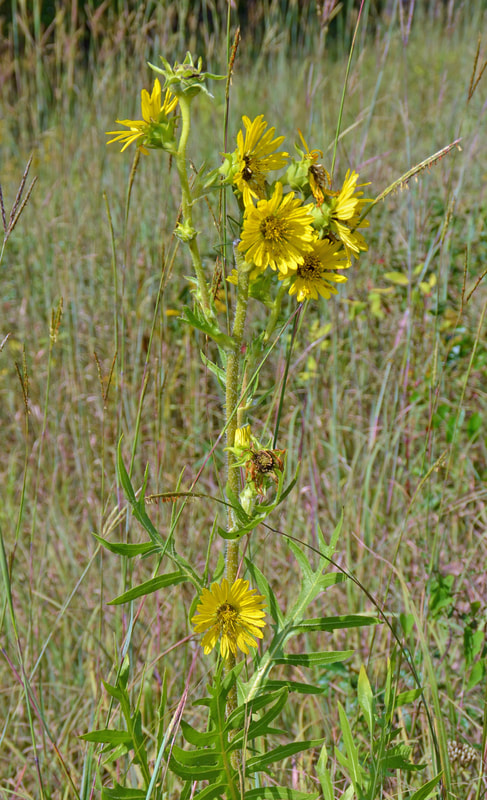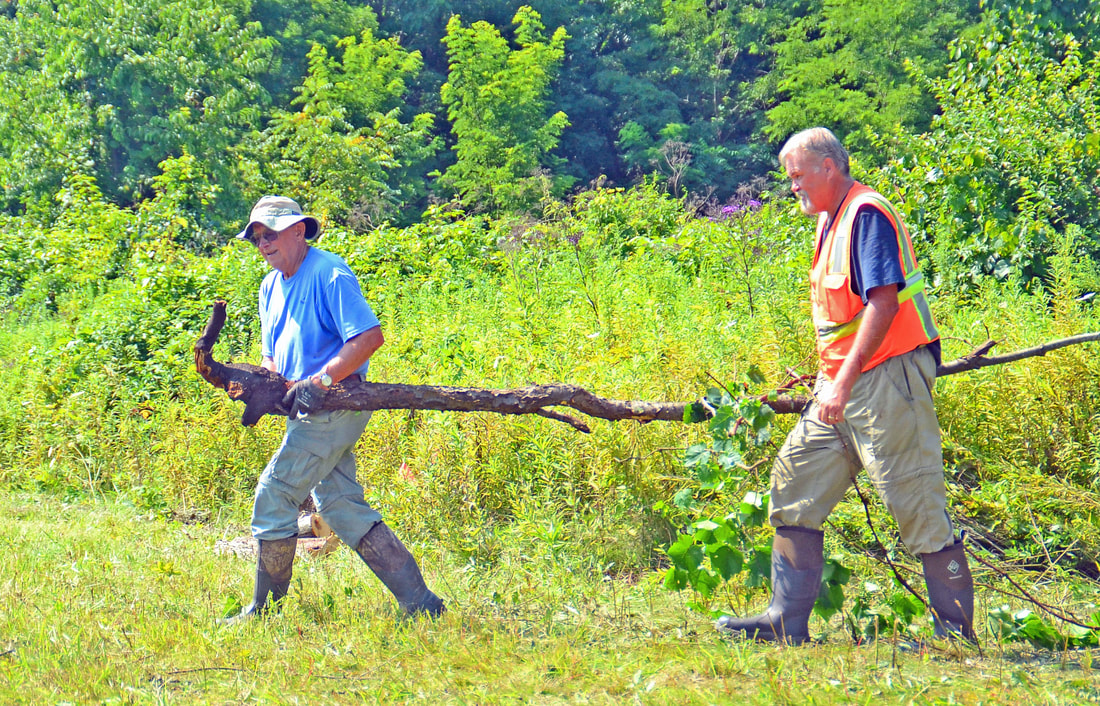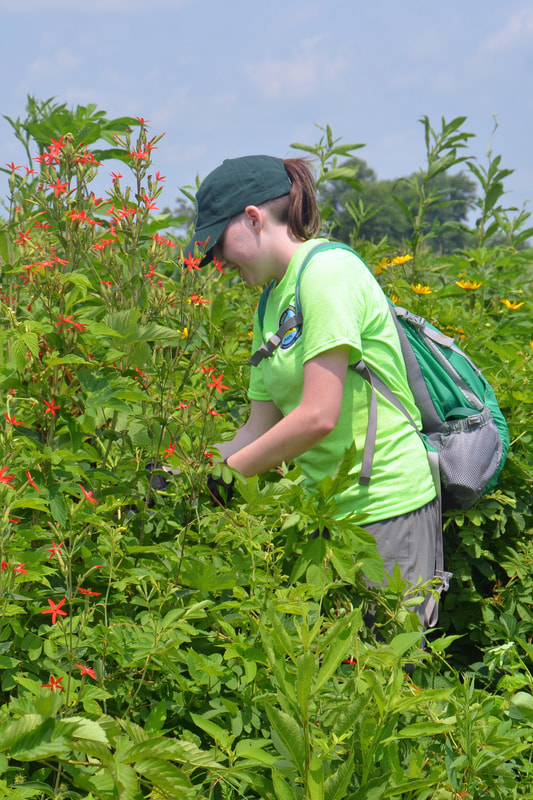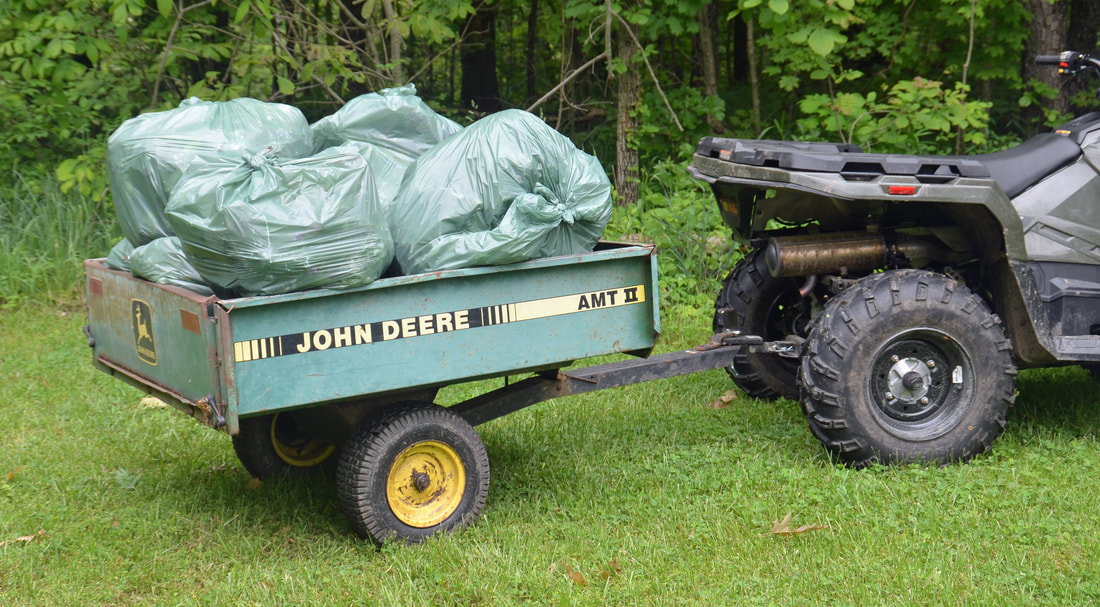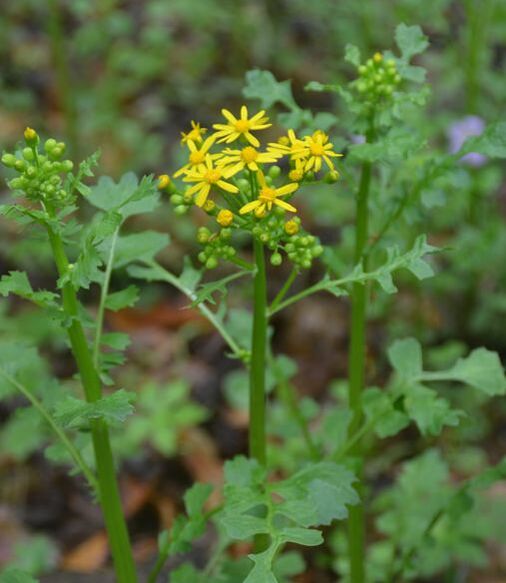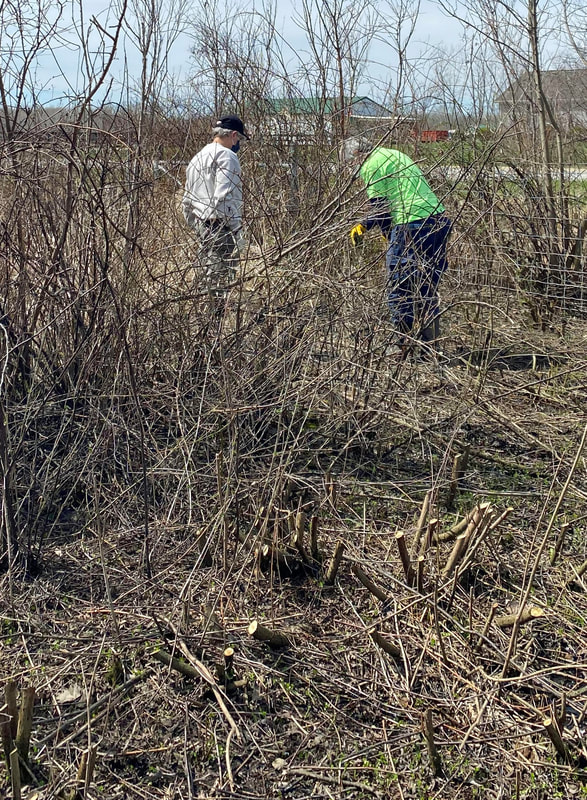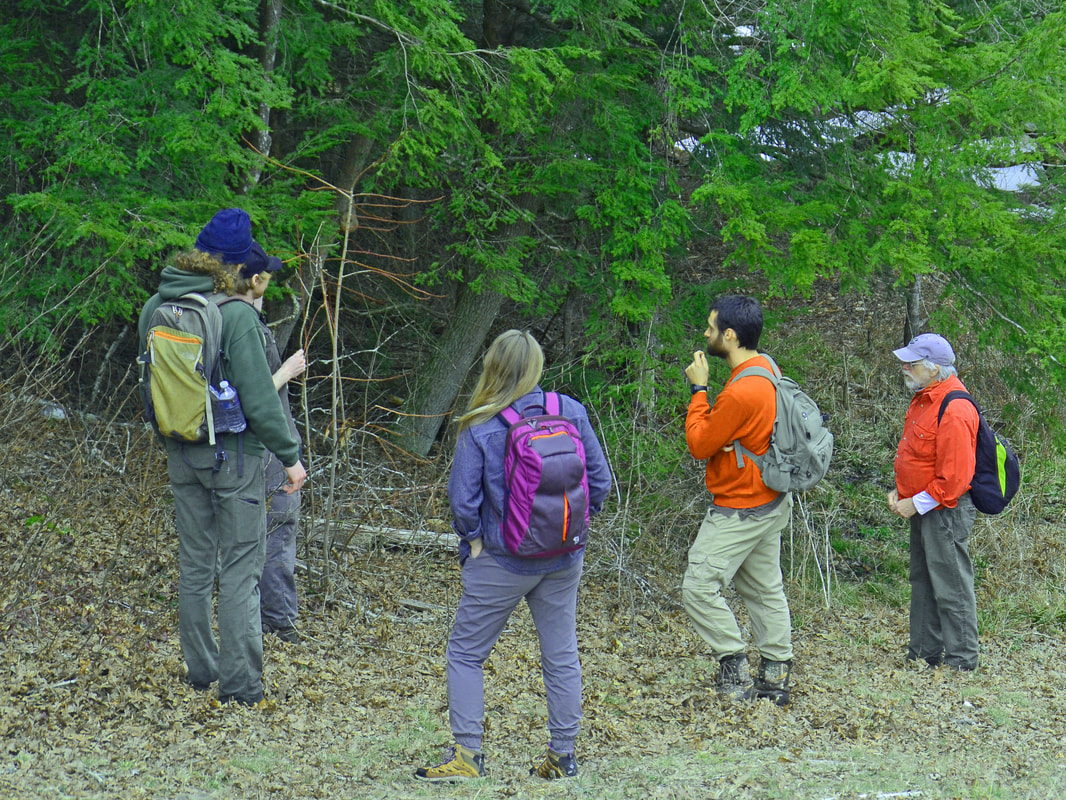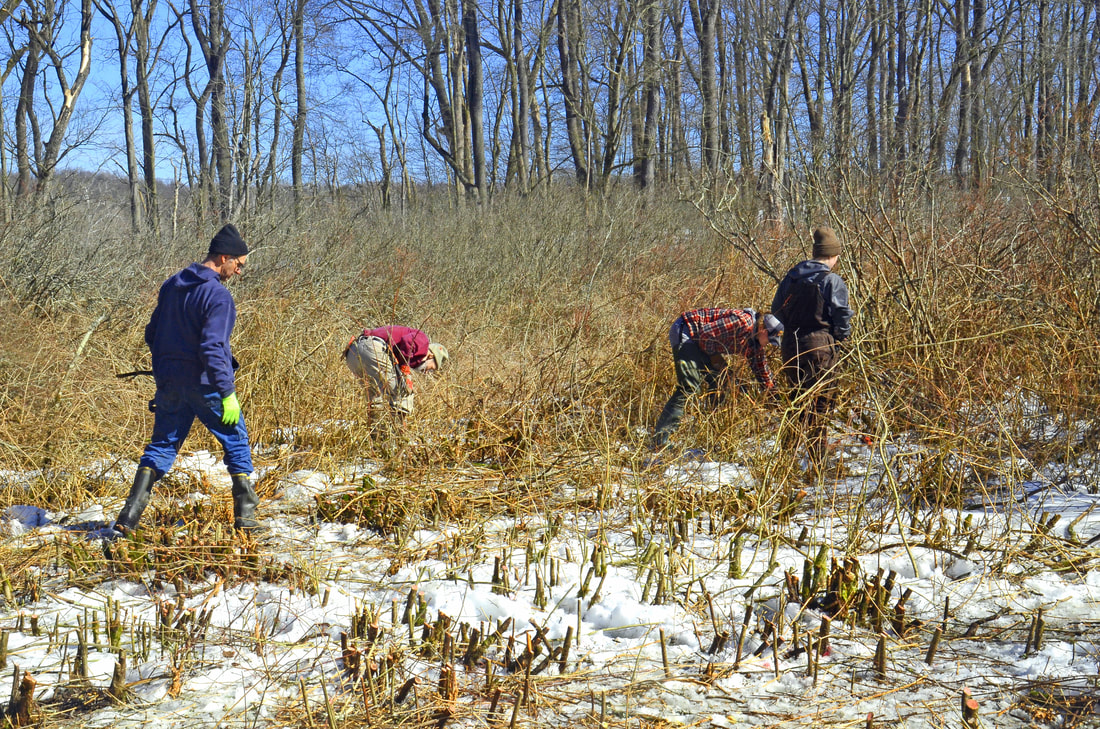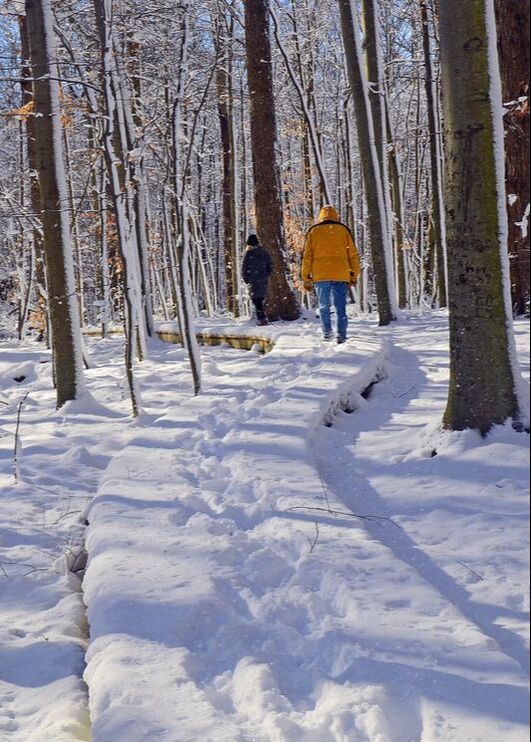2021 STEWARDSHIP PROJECT REPORTS
Two projects wrap up our 2021 stewardship season in the field
ONAPA finished the year with two added projects. On December 16, six ONAPA volunteers and stewardship assistants worked with six others from DNAP and USFWS at the Medway prairie fringed orchid site near Dayton to remove woody species in the meadow. We continue to open up this meadow and will have another project in March. On December 21, 16 people from ONAPA and DNAP collaborated at Myersville Fen to remove woody species in the north meadow, clearing a significant amount in the fen meadow.
ONAPA finished the year with two added projects. On December 16, six ONAPA volunteers and stewardship assistants worked with six others from DNAP and USFWS at the Medway prairie fringed orchid site near Dayton to remove woody species in the meadow. We continue to open up this meadow and will have another project in March. On December 21, 16 people from ONAPA and DNAP collaborated at Myersville Fen to remove woody species in the north meadow, clearing a significant amount in the fen meadow.
Stewardship crews continue to work to eliminate unwanted plants from preserves
The last stewardship project in November had a small crew of seven working at Springville Marsh SNP on November 30. This included three staff from DNAP and four ONAPA volunteers. We worked on removing woody species in a small meadow on the north side of the road. On December 2, we had an excellent turnout of 16 people, including six from The Nature Conservancy and two from DNAP, working at Herrick Fen. We were clearing invasive woody species in the understory of the tamarack fen along the boardwalk. We accomplished a significant amount of clearing in several areas, working among the tamaracks, bayberry, highbush blueberry, and poison sumac. Another small crew of four from ONAPA worked with Kyle Bailey, land manager for the Crawford Park District, at Sears and Carmean Woods on December 9, removing invasive woody species such as Amur honeysuckle, Japanese barberry, privet, and multiflora rose in the understory.
Invasive woody species were targeted at TNC's Herrick Fen during the December 2 stewardship project.
|
Stewardship projects in November prove to be productive in several preserves
November has been busy with stewardship projects despite the cooler weather. On November 4, we worked at the Medway prairie fringed orchid site with 14 people, including eight from DNAP. We cleared plenty of woody species in the orchid areas and plan to work more this winter.
On November 9, six of us from ONAPA cleared more poison sumac and glossy buckthorn at Cranberry Bog, continuing to open up the bog meadows. Mid-November, we concentrated on Lakeside daisy areas. On November 10, we cut red cedars at Kelleys Island State Park while dispersing some daisy seeds. Then on November 18, 10 people from ONAPA, DNAP, and USFWS cleared more red cedars in Lakeside daisy habitat at the new portion of the state nature preserve in Marblehead. On November 16, 14 people including ONAPA volunteers, DNAP staff, and Summit County Metro Parks staff worked |
together at Karlo Fen to remove woody species in the fen meadow.
It has been a productive month so far, and we have one more project coming up at Springville Marsh on November 30. CONTACT US if you wish to help. We will have a few projects in December, then winter projects will start weekly in January. |
|
Day at Brinkhaven Barrens results in significant clearing of woody species
On Saturday, October 23, 12 ONAPA volunteers worked with Randy Carmel, President of the Killbuck Watershed Land Trust, at Brinkhaven Barrens State Nature Preserve in Holmes County. It was a beautiful day and the group accomplished a significant amount of clearing in the north barrens, removing sumac, hazelnut, hawthorn, and dogwood. Even a few maple trees were cut down by our stewardship assistant, Lydia to open up one of the edges of the barrens. This is a great partnership between ONAPA and the NE Ohio land trust. |
|
Cedar Bog October workday draws a crowd
One of our recent stewardship projects in October was to work at Cedar Bog on October 19. With a large group of 16 people, including two new volunteers, four staff from MAD Scientist Associates, and seven regular ONAPA volunteers, we broke into two groups. A group of five worked in the snake corridor again, removing woody species for massasauga habitat. The second group worked in the fen meadows removing woody species such as white cedar, tulip tree, dogwood, and spicebush. While these are native species, they should not be in the fen meadows as they provide too much shade for the fen plants. We made significant progress and hope to do more this winter. |
Meilke Road Savanna WA project removed woody stems and added monarch host plants
The final stewardship project for September was at Meilke Road Savanna Wildlife Area in the Oak Openings on September 30. While we had a small group of six people, plenty of woody stems were removed and treated in the "bowl area" where lupines, puccoons, and other rare plants occur. We were also able to collect and spread butterflyweed seeds on one of the recently disturbed dune areas at the edge of the "bowl". This disturbance work was done by Division of Wildlife staff to improve habitat for sand barrens species and it is recovering well.
Woody invasive plants no match for ONAPA volunteers in preserves
|
ONAPA had two stewardship projects recently at Erie Sand Barrens SNP (September 21) and Herrick Fen SNP (September 23). Both focused on the removal and treatment of invading woody species. Seven ONAPA volunteers worked with DNAP preserve manager, Warren Dunegan at Erie Sand Barrens to remove black locust, sassafras, and sumac in an area with prairie and barrens plants. Seven ONAPA volunteers worked with five staff from The Nature Conservancy to remove glossy buckthorn and other woody invasives in the fen meadows along the boardwalk at Herrick Fen, our third season to partner with TNC at this high-quality fen preserve.
|
September stewardship projects get off to a great start in preserves around Ohio
September has been a busy month already for our stewardship crew. We started with Cranberry Bog on September 7, continuing to clear out the bog meadows choked primarily with poison sumac and glossy buckthorn. We worked at Cedar Bog on September 14 with 15 people, including a mix of partners, continuing to open up massasauga habitat. On September 16, we visited a new site for ONAPA, working with the Cleveland Museum of Natural History to remove invading glossy buckthorn at one of their fen preserves in Ashtabula County. We partnered with the Greater Cleveland Audubon Society on September 18 to help them remove invasive woody species near the lake at Aurora Sanctuary. This workday included an impressive group of 19 people from ONAPA, DNAP, and Audubon. (Photos by Jennifer Windus, except where noted).
September has been a busy month already for our stewardship crew. We started with Cranberry Bog on September 7, continuing to clear out the bog meadows choked primarily with poison sumac and glossy buckthorn. We worked at Cedar Bog on September 14 with 15 people, including a mix of partners, continuing to open up massasauga habitat. On September 16, we visited a new site for ONAPA, working with the Cleveland Museum of Natural History to remove invading glossy buckthorn at one of their fen preserves in Ashtabula County. We partnered with the Greater Cleveland Audubon Society on September 18 to help them remove invasive woody species near the lake at Aurora Sanctuary. This workday included an impressive group of 19 people from ONAPA, DNAP, and Audubon. (Photos by Jennifer Windus, except where noted).
|
Compass Plants in Ohio's only native site get counted during ONAPA survey for the Division of Natural Areas database
On Tuesday, August 24, Jennifer Windus and the four ONAPA stewardship assistants made the long trek south to Lawrence County to Compass Prairie State Nature Preserve (access by written permit only). This is the only native site in Ohio for compass plant, a state endangered plant. It had not been monitored, including counting all plants, for several years. DNAP contracted to have woody species removed over the winter since the prairie was getting very overgrown. This prairie has a' good diversity of prairie plants, but the compass plant is the rarest and most well-known at this preserve. Enduring heat and humidity, seed ticks and chiggers, our crew counted over 1,000 plants, including over 100 flowering plants, and mapped the population with a GPS unit. In addition, there are many young plants, indicating reproduction is occurring. This was a great experience for our stewardship assistants, who have been surveying for several rare plants this year to assist DNAP with records for the Natural Heritage Database. |
|
Woody species cleared at Wolf Run and Myersville Fen
On Tuesday, August 10, our ONAPA stewardship assistants worked with Lori Totman, Knox County Park District Director, and three of her interns at Wolf Run Regional Park to remove woody species in one of the burn units. This was a cooperative project since ONAPA did some prescribed burning for the park district this spring at Wolf Run. We removed and treated autumn olive, black locust and multiflora rose in one of the units on Yauger Road in Mount Vernon. It was a great opportunity for our stewardship assistants to interact with the Wolf Run interns. On Tuesday, August 17, 10 ONAPA volunteers and assistants worked with DNAP staff at Myersville Fen to remove invading woody species as well as cattails in one of the two fen meadows. This is important stewardship to maintain the open meadows for a number of rare fen plant species. The rain chased us out early, but we were able to clear plenty before the rain moved in. |
Myersville Fen crew - photo by Jennifer Windus.
|
Stewardship project turnout benefits from good weather in early August
|
Above: Jeff Davis and Bob Glotzhober haul out a log at Cedar Bog, adding to the pile pictured at right. Below: Kent Bog participant turnout was, well, BIG.
|
ONAPA had two excellent stewardship projects in early August with record turnouts since the start of the pandemic. On Tuesday, August 3, 13 ONAPA volunteers and six DNAP staff worked together at Kent Bog to remove glossy buckthorn in the shrub thickets. Larger shrubs were cut and treated with herbicide while smaller ones pulled out. Adam Wohlever, preserve manager, also girdled red maples growing in the shrubs and providing significant shade.
On Thursday, August 5, ONAPA organized a great partners stewardship day at Cedar Bog (actually a fen). We partnered with DNAP, Cedar Bog Association and several herpetologists who have been studying massasaugas in the fen. The 18 participants, including eight from ONAPA volunteers, cleared a significant corridor to a wooded area, connecting two meadows for massasauga habitat. ONAPA will continue this work on September 14 and October 19 (see Fall Stewardship Projects). |
Stewardship project crews stay busy during the summer heat of late June into July
ONAPA stewardship assistants and volunteers have been busy over the past month working with DNAP preserve staff. On Saturday, June 26, ONAPA had seven people work at Daughmer Savanna, which is managed by the Crawford County Park District. We removed teasel and woody species, and cleared some trails.
On July 15, we removed invasive plants at Milford Center Prairie. DNAP had woody species removed in the winter, so we worked on mullein, teasel, giant ragweed and sweet clover. The prairie plants are looking impressive and responding well to the clearing.
On July 17, a crew of eight worked at Jackson Bog, removing purple loosestrife and cattails. It threatened rain but we were able to accomplish three hours of work.
At Clifton Gorge on July 22, we pulled a recent invasion of Japanese stiltgrass along the river through the gorge and removed woody species such as bush honeysuckle on the scientific side of the preserve.
Despite the heat and recent rain, we continue to make progress with habitat management thanks to our stewardship assistants and volunteers.
On July 15, we removed invasive plants at Milford Center Prairie. DNAP had woody species removed in the winter, so we worked on mullein, teasel, giant ragweed and sweet clover. The prairie plants are looking impressive and responding well to the clearing.
On July 17, a crew of eight worked at Jackson Bog, removing purple loosestrife and cattails. It threatened rain but we were able to accomplish three hours of work.
At Clifton Gorge on July 22, we pulled a recent invasion of Japanese stiltgrass along the river through the gorge and removed woody species such as bush honeysuckle on the scientific side of the preserve.
Despite the heat and recent rain, we continue to make progress with habitat management thanks to our stewardship assistants and volunteers.
ONAPA busy helping root out invasives many habitats: bogs, prairies and forests
On Tuesday, June 8, eight ONAPA volunteers worked with two DNAP staff at Chaparral Prairie in Adams County to pull the invasive sweet-clover from two different areas. Sweet-clover can be hard to pull, especially when the soil is dry but we all worked hard to pull out as much as possible to improve the prairie habitat.
On Wednesday, June 9, a small group of eight ONAPA volunteers collected purple loosestrife beetles and larva from Moxley Wildlife Area and delivered them to Jackson Bog SNP. This is our third year of doing this transfer to help control purple loosestrife at Jackson Bog. This is a type of biological control where a small beetle native to Europe that feeds on purple loosestrife leaves has been introduced to control purple loosestrife in wetlands. We collect them in small mesh bags, travel to the new introduction site, and release them onto purple loosestrife plants.
On Thursday, June 17, five ONAPA volunteers worked with four DNAP staff at Hueston Woods scouting the woods for Japanese stiltgrass. We are trying to be proactive by scouting for this invasive grass and implement aggressive control methods to limit its spread. The grass primarily occurs on the perimeter of the preserve in the state park currently and fortunately very little was found in the interior of the woods.
On Tuesday, June 8, eight ONAPA volunteers worked with two DNAP staff at Chaparral Prairie in Adams County to pull the invasive sweet-clover from two different areas. Sweet-clover can be hard to pull, especially when the soil is dry but we all worked hard to pull out as much as possible to improve the prairie habitat.
On Wednesday, June 9, a small group of eight ONAPA volunteers collected purple loosestrife beetles and larva from Moxley Wildlife Area and delivered them to Jackson Bog SNP. This is our third year of doing this transfer to help control purple loosestrife at Jackson Bog. This is a type of biological control where a small beetle native to Europe that feeds on purple loosestrife leaves has been introduced to control purple loosestrife in wetlands. We collect them in small mesh bags, travel to the new introduction site, and release them onto purple loosestrife plants.
On Thursday, June 17, five ONAPA volunteers worked with four DNAP staff at Hueston Woods scouting the woods for Japanese stiltgrass. We are trying to be proactive by scouting for this invasive grass and implement aggressive control methods to limit its spread. The grass primarily occurs on the perimeter of the preserve in the state park currently and fortunately very little was found in the interior of the woods.
|
Augusta-Anne Olsen SNP now has less Dame's rocket On Thursday, June 3, eight ONAPA volunteers and stewardship assistants worked with DNAP staff at Olsen Preserve to pull and remove garlic mustard and Dame's rocket - 16 large bags! We had a good day working in a large area in the woods to remove these two invasive plants, then went on a nice hike through the preserve and along the Vermilion River. Several new staircases are being built and will improve the hiking experience here. |
|
ONAPA's help with Lakeside daisy mapping important to species recovery plan
During the month of May, three ONAPA stewardship assistants and Jennifer Windus assisted DNAP and USFWS with an important mapping and population estimate project for the Lakeside daisy on all six locations for this Federal threatened species. Every five years, the USFWS is expected to conduct a five-year status review to evaluate how the species is doing on a national level. In Ohio, this involves visiting the sites (two on Marblehead Peninsula, one at Castalia Quarry, and three on Kelleys Island). We are mapping the existing patches with a GPS unit and estimating densities so that we can develop an accurate map of its distribution, as well as a estimate of population size. It is very tedious work and must be done consistently so the results can be compared to the 2015 status review. ONAPA has already spent nine days on this project, with a couple more to go. ONAPA is a significant part of this important project and it gives our stewardship assistants great experience. |
Volunteers pull butterweed and garlic mustard at Fowler Woods, Clear Fork preserves
|
On Tuesday, May 4, seven ONAPA volunteers worked with two DNAP staff at Fowler Woods SNP to scout the preserve for garlic mustard and butterweed. Butterweed is a new invasive plant expanding its range in Ohio (native further south) and impacting wet woodland areas in natural areas. While we did not find much garlic mustard, we did find a lot more butterweed than last year in the wet areas at Fowler Woods. We pulled a significant amount and identified some dense areas that the DNAP preserve manager will selectively spray with herbicide. Watch out for this new invasive and let us know if you see it in a nature preserve!
On Thursday, May 13, six ONAPA volunteers worked with two DNAP staff at Clear Fork Gorge SNP, within Mohican SP and SF, to pull garlic mustard. While there is plenty of garlic mustard in the surrounding state park and state forest, we are working hard to control it in the nature preserve. This small, majestic preserve holds large white pine and hemlock trees with some rare plants in the understory. It is always a beautiful hike! |
ONAPA had two more garlic mustard control projects at the end of April. On Tuesday, April 27, eight ONAPA volunteers worked with three DNAP staff at Rhododendron Cove State Nature Preserve to pull garlic mustard. There is a huge infestation there this year and we pulled 15-20 large garbage bags filled with garlic mustard. On Thursday, April 29, three ONAPA volunteers worked with three DNAP staff at Hueston Woods SNP and pulled 23 large garbage bags of garlic mustard. While some sites have had declines in garlic mustard this year, these two preserves had plenty to pull!
|
Clearing the way for wildflowers at Lake Katharine State Nature Preserve
On Tuesday, April 19, four ONAPA volunteers worked with preserve manager Coleman Minney at Lake Katharine scouting the floodplains for garlic mustard, pulling as we went. We have covered these areas of the preserve before and it was encouraging to see that there is much less garlic mustard at present. We pulled the plants and carried them out in plastic bags to make sure they did not produce seeds as they were already in flower. The wildflower display in the floodplains was impressive, full of bluebells, large-flowered trillium, spring-beauty, chickweed, and Dutchman's-breeches. |
|
Prescribed burns help prairie habitat during March and April with ONAPA help
|
ONAPA has been busy in late March through mid-April conducting prescribed burns in cooperation with several of our partners. ONAPA has a small burn team and we work in cooperation with other agencies and private landowners to implement prescribed fire as needed on natural areas such as prairies and savannas. This spring we conducted burns on 10 different sites, including units at Daughmer Savanna SNP with Crawford County Park District, Wolf Run and Honey Run Highlands with Knox County Park District, Deep Cut and Archery Range with Johnny Appleseed Metropolitan Park District, and five privately-owned prairies. Guy Denny and Jennifer Windus served as the certified fire managers for these burns.
|
|
March weather finally cooperates for Medway Prairie Fringed Orchid project
|
On Tuesday, March 30, four ONAPA volunteers worked with DNAP and USFWS at the Medway Prairie Fringed Orchid site to remove invading woody species. This project had been cancelled twice in March due to the weather, so we were glad to finally get some work done there removing willows and dogwoods. ONAPA has worked with DNAP and USFWS typically in the spring and fall to remove woodies for the past several years and the site is finally looking more open again. We are hopeful that the prairie fringed orchids will respond well this summer!
|
On Tuesday, March 16, eight ONAPA volunteers worked with DNAP preserve manager, Warren Dunegan on the barrier beach at Sheldon Marsh to remove woody species in the beach grass areas. This was a new project for ONAPA and we all enjoyed working on the beach on a beautiful, sunny day. We worked in several small openings among the cottonwoods where there is beach grass, rare sedges, and beach wormwood, a state threatened plant. The beach area has grown up in woody species such as willows, cottonwood, dogwood, and osage orange over the years, plus many larger cottonwoods have fallen down on the beach from storms and higher lake levels. Our project was a great start to restoring some of the open beach habitat for rare plants and shore birds.
On Tuesday, March 23, six ONAPA volunteers worked at Killbuck Marsh Wildlife Area, in one of the sedge meadows where prairie fringed orchids occur. We removed willows, alders, and dogwoods, opening the sedge meadow which should improve the habitat. ONAPA will assist with surveys this summer to see how many blooming orchids are found.
On Tuesday, March 23, six ONAPA volunteers worked at Killbuck Marsh Wildlife Area, in one of the sedge meadows where prairie fringed orchids occur. We removed willows, alders, and dogwoods, opening the sedge meadow which should improve the habitat. ONAPA will assist with surveys this summer to see how many blooming orchids are found.
|
Early March weather a mixed bag for stewardship projects
ONAPA started March out with three stewardship projects at Little Rocky Hollow, Mallard Club Wildlife Area, and Jackson Bog. At Little Rocky Hollow on March 3, three ONAPA volunteers worked with five DNAP staff to conduct surveys for hemlock wooly adelgid. (The project was moved from nearby Sheick Hollow because the parking area was impassable.) Fortunately we did not find any HWA, but the ice formations and waterfalls were spectacular. On a dreary, cold March 4, four ONAPA volunteers and one USFWS staff cleared woody species at Mallard Club Wildlife Area in Lucas County in one of the prairie fringed orchid areas. On March 9, a beautiful warm day, nine ONAPA volunteers worked with DNAP preserve manager, Charlotte Trolio, at Jackson Bog in one of the fen meadows. |
Volunteers removed invading woody species. This project had been rescheduled twice, but we had a great day and cleared a significant area, cutting glossy buckthorn, red maples, and alders.
|
Stewardship projects slated for mid-February finished the last week of the month
|
After two wintry weeks in mid-February where we cancelled four projects in a row, ONAPA was able to resume its stewardship projects with three the last week of the month. The weather was sunny and warm, almost spring-like, and volunteers were ready to get out again!
On Tuesday, February 23, seven volunteers worked with Randy Carmel, Killbuck Watershed Land Trust president, at Brinkhaven Oak Barrens to cut and treat woody stems in the south barrens. Burning a large brush pile kept us warm when the clouds and wind cooled the air temperatures. A significant section was cleared and the south barrens is looking good from all the work done this past year. On Wednesday, February 24, second HWA survey at Lake Katharine with eight people, including three from DNAP. We surveyed a different area than we did on February 4 and did not find any HWA. It was a beautiful day with 61 degrees and amazing ice formations. On Thursday, February 25, six volunteers and three DNAP staff worked at Bonnett Pond Bog in Holmes County to clear woody species in the bog meadow. The ice was firm enough that we could walk across the moat to the bog meadow (which does not freeze every year). We cut and treated invading highbush blueberry, dogwood, buttonbush, and viburnum, while managing to avoid the poison sumac! This work is critical to maintain the sphagnum bog meadow with large cranberry, sedges, and other rare bog species. |
|
First Lake Katharine HWA survey completed and second survey planned
On Thursday, February 4, three ONAPA volunteers and two Crane Hollow staff worked with preserve manager, Coleman Minney to survey for Hemlock Wooly Adelgid (HWA) at Lake Katharine Preserve. HWA has been found there before and is unfortunately well-established in a large area of the preserve, despite on-going treatments. We hiked a large area on the north side of Lake Katharine, surveying the underside of hemlock branches to look for the characteristic white, fuzzy dots (see photo) of HWA at this time of year. With six of us doing the survey, we hiked in a well-spaced line so that we could survey as many trees with low-hanging branches as possible. We did find more trees infected with HWA, which was disappointing, but this information will help DNAP determine the best approach for treatment this year. |
Three projects start off winter 2021 with removing woody species from open habitat
|
ONAPA started its winter stewardship projects on Thursday, January 7, at Erie Sand Barrens (photos top right) . We are happy to have hosted three projects before mid-January, and the weather has cooperated. At Erie Sand Barrens, seven people from ONAPA and DNAP worked together to clear and treat woody stems growing in one of the high-quality sand barren areas with several rare plants. It has grown up in aspens, willows, and dogwoods, but we got a great start in opening it up again. DNAP plans to conduct a prescribed burn at the preserve in the spring, so this should also help to control the woody species.
On Wednesday, January 13, ONAPA and DNAP worked with Beaver Creek Wetlands Association (BCWA) at Zimmerman Prairie near Dayton to cut and treat woody species invading the small wet prairie. There was a great turnout with 14 people, including six from ONAPA. BCWA now manages the site in cooperation with DNAP and they have worked hard recently to control cattails and woody species. They were very grateful to have our help. We have another project scheduled with them in February. (Photos middle right). On Thursday, January 14, seven people from ONAPA and DNAP |
worked together at Kiser Lake Wetlands (bottom photos) to cut and treat woody species in the fen meadow in the Grandview Heights section. This continues the work we did last September. Between both
|
days, the meadow adjacent to Kiser Lake is looking much more open, so we are excited to see the response this summer. We removed willows, autumn-olive, dogwoods, multiflora rose, privet, and bush honeysuckle, while avoiding the poison sumac. |
New boardwalk at Fowler Woods a pleasure to walk during any season
|
By Dick Moseley
Fowler Woods Nature Preserve opened again to visitors October 26 after the new boardwalk was completed ahead of schedule . The Division of Natural Areas and Preserves held a ribbon-cutting ceremony October 23 to reopen the preserve for visitation on the preserve’s new boardwalk. ODNR Director Mary Mertz and DNAP Chief Jeff Johnson spoke to the small gathering of ten invited guests at a ribbon-cutting ceremony to dedicate the walkway that replaced the 40-year-old boardwalk. Jagger Construction Company of Lima replaced the 1-1/4 mile trail with a fully accessible trail from the entrance parking lot. Whether physically challenged or accompanied by young children, everyone has an opportunity to experience this beautiful Beech-Maple Swamp Forest. The trail winds through the wetland swamp forest and the upland beech and maple forest, offering a variety of habitats and flora. The project. costing $ 486,200, was funded by an 80 percent Federal Recreation Trail Grant, matched by the Division of Natural Areas & Preserves' 20 percent, which was financed from the Income Tax Checkoff Program. Come enjoy this beautiful Nature Preserve, whether snow-covered in winter or when spring wildflowers are on full display. |

